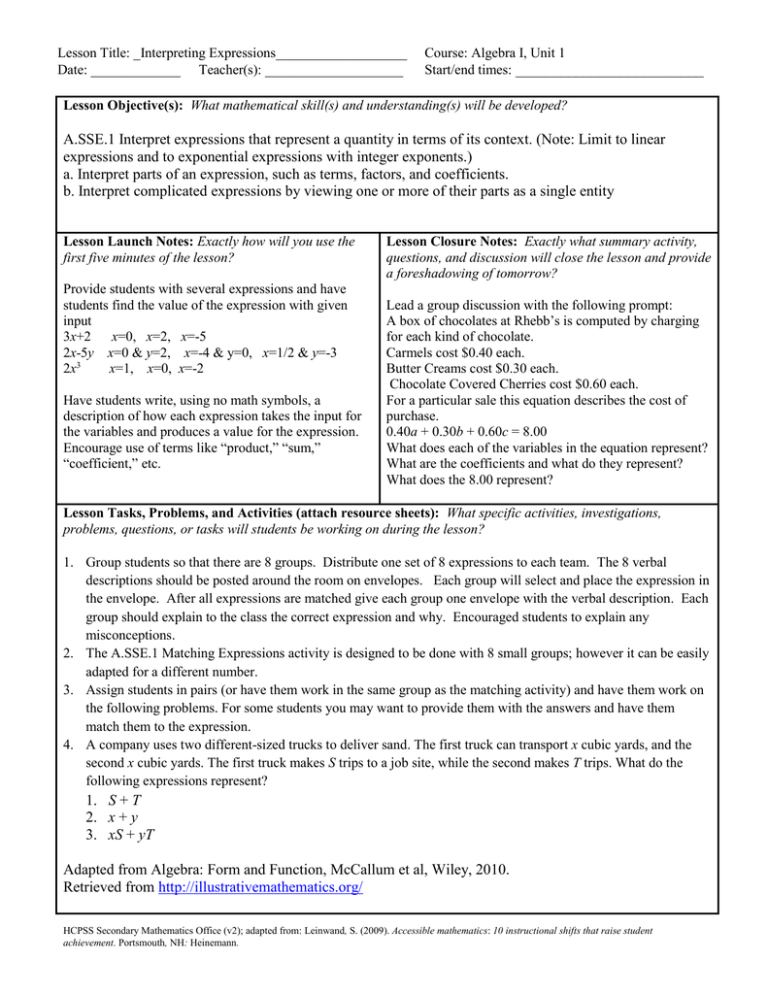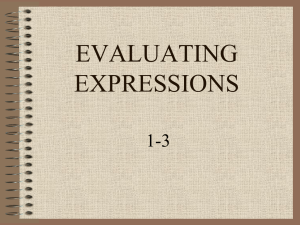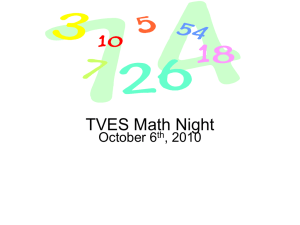Lesson Interpreting Expressions
advertisement

Lesson Title: _Interpreting Expressions___________________ Date: _____________ Teacher(s): ____________________ Course: Algebra I, Unit 1 Start/end times: _________________________ Lesson Objective(s): What mathematical skill(s) and understanding(s) will be developed? A.SSE.1 Interpret expressions that represent a quantity in terms of its context. (Note: Limit to linear expressions and to exponential expressions with integer exponents.) a. Interpret parts of an expression, such as terms, factors, and coefficients. b. Interpret complicated expressions by viewing one or more of their parts as a single entity Lesson Launch Notes: Exactly how will you use the first five minutes of the lesson? Provide students with several expressions and have students find the value of the expression with given input 3x+2 x=0, x=2, x=-5 2x-5y x=0 & y=2, x=-4 & y=0, x=1/2 & y=-3 2x3 x=1, x=0, x=-2 Have students write, using no math symbols, a description of how each expression takes the input for the variables and produces a value for the expression. Encourage use of terms like “product,” “sum,” “coefficient,” etc. Lesson Closure Notes: Exactly what summary activity, questions, and discussion will close the lesson and provide a foreshadowing of tomorrow? Lead a group discussion with the following prompt: A box of chocolates at Rhebb’s is computed by charging for each kind of chocolate. Carmels cost $0.40 each. Butter Creams cost $0.30 each. Chocolate Covered Cherries cost $0.60 each. For a particular sale this equation describes the cost of purchase. 0.40a + 0.30b + 0.60c = 8.00 What does each of the variables in the equation represent? What are the coefficients and what do they represent? What does the 8.00 represent? Lesson Tasks, Problems, and Activities (attach resource sheets): What specific activities, investigations, problems, questions, or tasks will students be working on during the lesson? 1. Group students so that there are 8 groups. Distribute one set of 8 expressions to each team. The 8 verbal descriptions should be posted around the room on envelopes. Each group will select and place the expression in the envelope. After all expressions are matched give each group one envelope with the verbal description. Each group should explain to the class the correct expression and why. Encouraged students to explain any misconceptions. 2. The A.SSE.1 Matching Expressions activity is designed to be done with 8 small groups; however it can be easily adapted for a different number. 3. Assign students in pairs (or have them work in the same group as the matching activity) and have them work on the following problems. For some students you may want to provide them with the answers and have them match them to the expression. 4. A company uses two different-sized trucks to deliver sand. The first truck can transport x cubic yards, and the second x cubic yards. The first truck makes S trips to a job site, while the second makes T trips. What do the following expressions represent? 1. S + T 2. x + y 3. xS + yT Adapted from Algebra: Form and Function, McCallum et al, Wiley, 2010. Retrieved from http://illustrativemathematics.org/ HCPSS Secondary Mathematics Office (v2); adapted from: Leinwand, S. (2009). Accessible mathematics: 10 instructional shifts that raise student achievement. Portsmouth, NH: Heinemann. Lesson Title: _Interpreting Expressions___________________ Date: _____________ Teacher(s): ____________________ Course: Algebra I, Unit 1 Start/end times: _________________________ (Note: In the trucking task students, are interpreting different expressions using four variables in a real world context. The later parts build on the earlier ones. All expressions describe quantities that a truck company might want to look at when planning for a job.) Students should now be ready to practice interpreting expressions independently. Evidence of Success: What exactly do I expect students to be able to do by the end of the lesson, and how will I measure student mastery? That is, deliberate consideration of what performances will convince you (and any outside observer) that your students have developed a deepened (and conceptual) understanding. Given an expression, students will be able to evaluate it correctly for various values of the variables. Given an expression or expressions with variables defined in an application, students will be able to evaluate the expressions and will be able to interpret the expressions based on the operations and uses of the variables. Notes and Nuances: Vocabulary, connections, common mistakes, typical misconceptions, etc. Vocabulary: Coefficient, Product, Sum, Difference, Quotient Resources: What materials or resources are essential for students to successfully complete the lesson tasks or activities? Homework: Exactly what follow-up homework tasks, problems, and/or exercises will be assigned upon the completion of the lesson? Teacher resource sheet A.SSE.1 Matching Expressions To be determined by the teacher. Lesson Reflections: What questions, connected to the lesson objectives and evidence of success, will you use to reflect on the effectiveness of this lesson? Do all students have a conceptual understanding of how to interpret expressions that represent a quantity in terms of its context? Do all students have the skill to identify parts of the expression in an application and describe their function? What modifications to future instruction (if any) should be made based on the outcomes of this lesson? HCPSS Secondary Mathematics Office (v2); adapted from: Leinwand, S. (2009). Accessible mathematics: 10 instructional shifts that raise student achievement. Portsmouth, NH: Heinemann.








